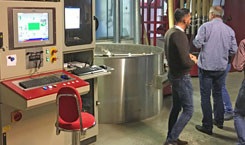Coffee roasting
Roasting coffee is crucial for the approximately 800 aroma compounds that determine the taste of coffee. A range from dark chocolate to roasted peanuts to fruity wild berries can give coffee its unique aroma.
Why is coffee roasted?
It is only through roasting, the dry heating of clean coffee beans, that the flavors that make this stimulating beverage so unique unfold. Anyone who has seen coffee cherries knows that they have little in common with the dark, aromatic beans that go into an espresso machine. After the seeds are extracted and dried, what remains are small, light-colored coffee beans called green coffee. Many coffees contain relatively high levels of chlorogenic acid and would be somewhere between unpalatable and unhealthy in raw form. Depending on the condition of the green coffee and the demands placed on the final product, there are numerous roasting methods and as many roasting recipes as there are types of coffee. Today, as never before, coffee roasting has become a craft and is becoming a trend in Germany as well.
The roasting process
At 180°C to 230°C, the green coffee is exposed to a dry heat. It is constantly turned mechanically to ensure even roasting and prevent scorching. Between eight and twenty minutes, the beans can go through various cycles in the roaster. By deliberately controlling the air, smoky aromas can be created. Additives are not added. Various processes are set in motion in the roaster:
The heat causes the water content to drop from 10-13% to 1-2.5%; the resulting weight loss is called "objection."
The skin of the beans bursts open due to a volume increase of up to 70% and the aromatic coffee oil escapes.
During the so-called Maillard reaction, the beans get their brown color. In this process, a few starting substances are transformed into up to 1000 different aroma substances, which give the coffee its unique aroma.
The fructose contained in the bean caramelizes and, depending on the sugar content and the degree of caramelization, determines the sweetness of the coffee.
Caffeine is heat-resistant and is retained, while pesticides are completely degraded. This means that even non-organic coffees are safe to drink.
The acid contained in coffee is reduced and transformed primarily by gentle and slow roasting.
Gently roasted coffees are therefore particularly mild. Two main methods are used for roasting, the drum roasting method and the hot air roasting method. You can read more about the differences here. Depending on the temperature, duration and type of roasting, the many different roasts are created, which we know by many different names. Filter coffee, for example, is roasted relatively light and thus develops less bitterness, while espresso blends remain longer in the roaster and become somewhat darker.

